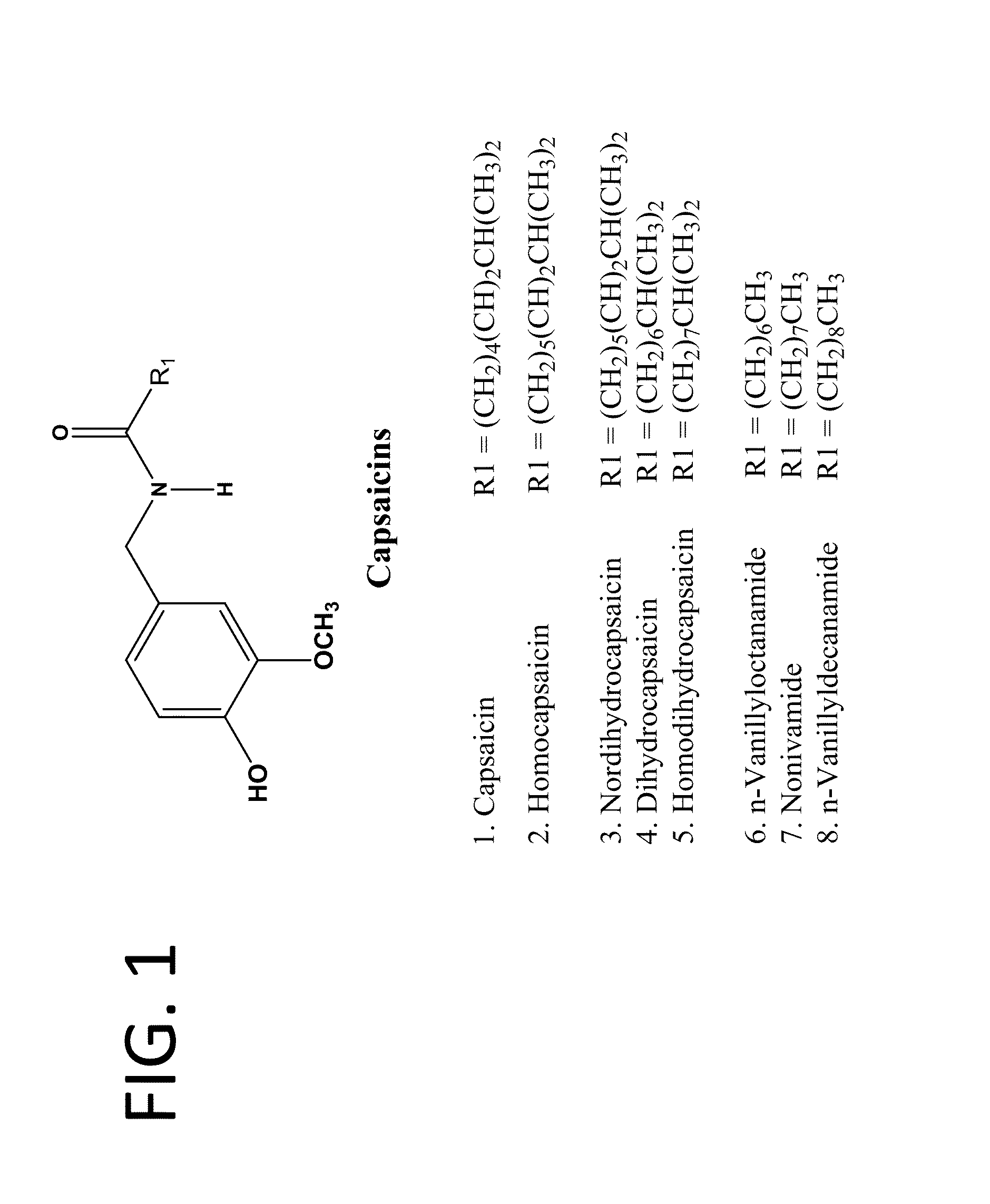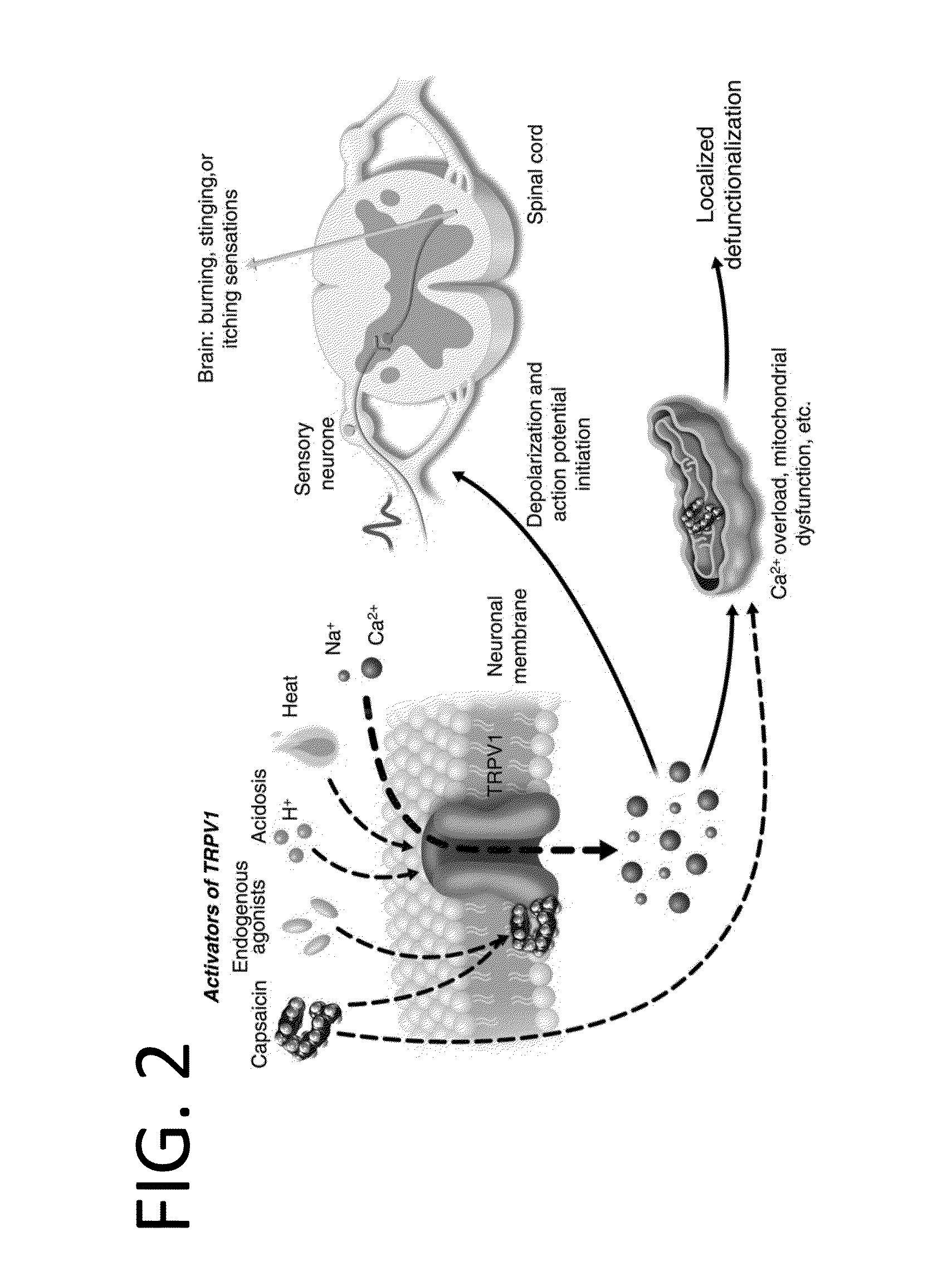Pharmaceutical Compositions Comprising Capsaicin Esters for Treating Pain and Cold Sores
a technology of capsaicin and esters, which is applied in the field of medicines and therapeutics, can solve the problems of poor patient compliance with these products, limited efficacy, and unsatisfactory in several respects, and achieve the effects of shortening the action potential duration of ventricular myocytes, increasing contractile force and blood pressure, and improving patient complian
- Summary
- Abstract
- Description
- Claims
- Application Information
AI Technical Summary
Benefits of technology
Problems solved by technology
Method used
Image
Examples
example 1
Preparation of Palmitoyl Ester of Capsaicin USP (Formula I, R=—(CH2)14—CH3)
[0197]A mixture of 1478 μm of capsaicin USP (HUBEI XIANGXI CHEMICAL INDUSTRY CO., LTD, China), 700 ml of anhydrous triethylamine (Spectrum Chemicals) and 7400 ml of anhydrous dichloromethane was charged into a 50 L double jacketed chemical glass reactor. The content was covered with aluminum foil to protect it from light exposure. The reactor was fitted with a condenser fitted with a moisture trap on the top and a drop wise addition funnel. The flask was kept at room temperature and 1260 ml of palmitoyl chloride was added from the funnel into the mixture slowly with stirring. After the addition, the mixture was refluxed for 8 hours and stirred for 10-15 hours at 40° C. temperature. The mixture was washed successively with 2×20 L of water, 2×20 L of 0.1N dilute hydrochloric acid, 2×20 L of 10% sodium bicarbonate solution and 3×20 L of type I water until the washed out solution was neutral. The organic layer wa...
example 2
Preparation of 14.25% Capsaicin Palmitate Ointment and Liquid
Formulation 1. Ointment
[0202]The following ingredients were weighed accurately and mixed in a 100 mL beaker while heating at 70° C. The mixture was cooled to room temperature and mixed again to obtain the specified ointment.
Capsaicin Palmitate (14.25%) Composition OintmentJar (gm) 5Batch Size (gm) 50.0CP Overage (%) 5AmountName of IngredientPercentBatch (gm)1Cetyl Myristoleate10.0005.0002Oleyl Alcohol20.00010.0003Capsaicin Palmitate14.25014.9637.4814Isopropyl Myristate20.00010.0005Lavender Oil2.0001.0006Glyceryl Monooleate10.0005.0007PEG 4004.0002.0008Polysorbate 803.0001.5009Propylene Glycol5.0002.50010Vitamin E Acetate2.0001.00011White Petroleum5.0002.50012Cetearyl Alcohol4.7504.0382.019TOTAL100.00050.000Total # of Jars 10
Formulation 2. Liquid
[0203]The following ingredients were weighed accurately and mixed in a 100 mL beaker while heating at 70° C. The mixture was cooled to room temperature and mixed again to obtain the...
example 3
Preparation of Capsaicin Palmitate (0.445%) and Menthol (3%) Cream
[0204]The ingredients listed in the following Table were separated into oil phase and water phase ingredients except benzyl alcohol. The oil phase ingredients were weighed accurately and transferred to a 500 mL beaker and heated to 60-70° C. The water phase ingredients were weighed accurately and transferred to a 1 L glass bowl and heated to 60-70° C. while stirring to form a homogeneous solution. The water phase was cooled to the room temperature and the oil was added slowly to the water phase with rapid mixing. Benzyl alcohol was added to the cream while rapidly mixing. The resultant cream was mixed for 10 minutes and allowed to cool to the room temperature.
Menthol (3%)& Capsaicin Palmitate (0.445%) CreamJar (gm) 35Batch Size (Gm) 500.0CP Overage (%) 5AmountName of IngredientPercentBatch (gm)1Menthol3.00015.002Camphor2.00010.002Capsaicin Palmitate0.4450.4672.343Lavender Oil0.0000.004Hallbrite BHB6.00030.005Glyceryl ...
PUM
| Property | Measurement | Unit |
|---|---|---|
| Percent by mass | aaaaa | aaaaa |
| Fraction | aaaaa | aaaaa |
| Weight | aaaaa | aaaaa |
Abstract
Description
Claims
Application Information
 Login to View More
Login to View More - R&D
- Intellectual Property
- Life Sciences
- Materials
- Tech Scout
- Unparalleled Data Quality
- Higher Quality Content
- 60% Fewer Hallucinations
Browse by: Latest US Patents, China's latest patents, Technical Efficacy Thesaurus, Application Domain, Technology Topic, Popular Technical Reports.
© 2025 PatSnap. All rights reserved.Legal|Privacy policy|Modern Slavery Act Transparency Statement|Sitemap|About US| Contact US: help@patsnap.com



